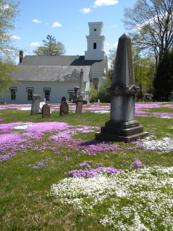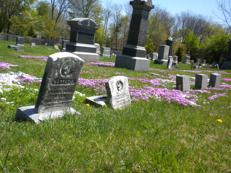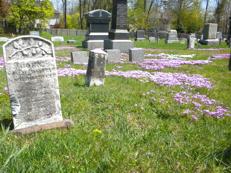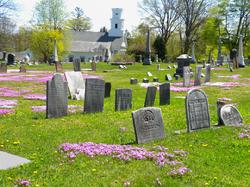The Chester Cemetery
Soon after the close of the pastorate of the Rev. Samuel Sweazy at the Black River church, the war of the Revolution began. The years 1777-78 were stirring times in New Jersey. Chester was off the line of conflict, and yet must have been a source of supply for the patriot army while encamped at Morristown. During these years worship was suspended and the Congregational Meeting house was used as a hospital for wounded and disabled soldiers and there are a number of soldiers buried in unmarked graves in the cemetery. Our goal is to place a marker for these Revolutionary War Soldiers.
This account, taken from the Parish Records of Feb. 17, 1849 (page 78) reads as follows; “The church, having passed a vote at their regular monthly meeting in May last, to the following effect. Whereas the present custom of standing at the graves of deceased until they are filled is often attended with great inconvenience; and to leave without ceremony would be considered indecorous; Therefore resolved that in conformity with the usages of sister churches that they be dismissed immediately after the coffin shall be deposited and in the grave and a small quantity of dirt thrown over it.”
In reference to the above resolve, Nathan A. Cooper, although not a church member, and not in a church meeting, but a general meeting of the Parish, presented the following resolution which was carried through not without remonstrance by the church as it was in opposition to their doings! “Resolve that this Parish and Congregation regard the rite of burial most sacred as a last tribute of respect to the remains of the departed and that we hereby repeal and disannul any resolutions here-to-fore passed authorizing the Pastor or any officer of the church to dismiss the relations and friends of the dead before the grave shall have been entirely filled and the dead decently buried out of sight.”
Also from our “Church History” book comes this account from July of 1850: “The practice of allowing cattle to pasture in the grave yard was considered as improper among the graves and it was resolved that the in future, there shall be no more of the practice allowed. A committee to improve the graveyard was appointed consisting of Jacob H. Crammer, Charles Ming and Stephen Budd.”
In 1816, a wooden fence was built to go around the cemetery at a cost of $284.43.
This notice from our church history dated December 11, 1909 read, “Take Notice! All persons who feel interested in incorporating and improving the Congregational burying grounds are requested to attend a meeting to be held in the Congregational Chapel on Saturday, January 1, 1910, at 3 PM for the purpose of organizing a Cemetery Association … By order of the Trustees of the First Congregational Church of Chester, New Jersey.”
In answer to the above call, the people assembled and elected George W. Howell the chairman and Silas H. Emmons, Secretary. The resolution adopted read that the Congregational Cemetery grounds be incorporated and known as the Chester Cemetery. In a September 30, 1910 meeting, the Trustees voted that a new stone fence be erected on the old foundation; along Railroad Avenue, with a six inch coping of German Valley Trap Rock.
The reason that the cemetery needed to be separated from the church was because the money from the sale of plots and burials had been flowing directly into the church coffers for expenses and nothing was available for cemetery upkeep. Separation would help to insure permanency of the cemetery, regardless of the ebb and flow of church membership.





